Cultural Studies:
I. "The Lady of Shalott"--A
feminist or a victim?
-
crisis in subjectivity--the use of
mirror
-
her education--ideologies
of Romantic love and Celibacy, etc.
-
different painters' interpretation
II. Culture Industry--theory
of Adorno & Horkheimer
Right
William Holman Hunt, The Lady of
Shalott, Manchester, Manchester City Art
Gallery (from Women/Image/Text)
Other Images of Shalott
by Hunt, Waterhouse,
Siddal, Egley
by Dante Gabriel Rossetti
Why do they choose the moment of the Lady's defiance? |
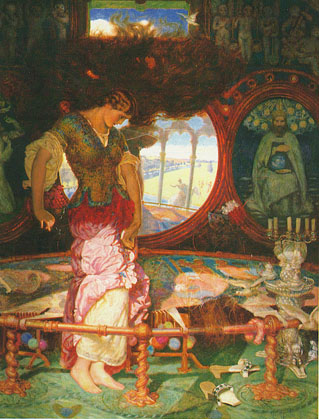 |
The Exotic & Chaotic background--
allegorical elements:
Please pay attention to the wall's dark tapestries, "upon
which swirl the twisting bodies of angelic and allegorical figures, while
the two roundels supporting the great mirror feature scenes of the Fall
and the nativity [Wadsworth]" (Pearce 79)
exotic elements:
sandals & samovars («X°ê»É³ý)
|
contending ideogies:
in the poem
The Lady is both a bewitching 'fairy' (Parts I and II) and a pure Virgin,
clothed in 'snowy white' (Part IV). --symbolic of a woman torn in
two by her contradictory education; by the "contending ideologies of Christian
Celibacy and Romantic Love, and both underscored by the socio-economic
forces that required a woman to marry or be rendered invisible."
in the painting by Hunt
[The painting is]"littered with graphic symbols of the contradictory
discourses (Celibacy and Romantic Love) by which the Lady has been interpellated.
Between the Garden of Eden and the Virgin birth, the harem and the cloister,
Hunt's Lady makes manifest the impossibility of her situation" (Pearce
78, 80)
Other Images of Shalott Hunt; Waterhouse
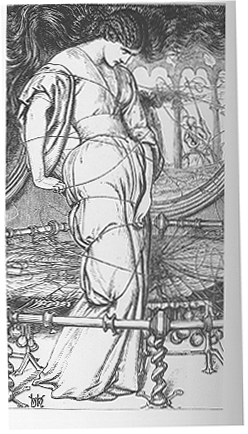 |
Hunt "allegedly intended his paintings and illustrations
to be read as reproving texts on the 'dereliction of duty'" (Pearce
78)
Hunt analysed the text as a moral fable illustrating 'the
failure of a human soul towards its accepted responsiblity" (qtd in Marsh
150).
Please pay attention to the strong limbs, the heavy hips
and breasts, and the witch-like hair.
William Holman Hunt, The Lady of Shalott,
1857 |
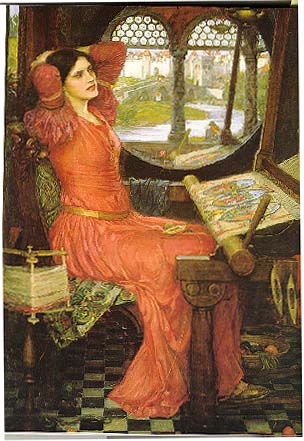 |
Is she a fallen woman or "snow-maiden"? Languorouss,
Doomed or expecting love?
John William Waterhouse
'I am Half Sick of Shadows' siad the Lady of Shalott,
1915 |
Egley & Siddal
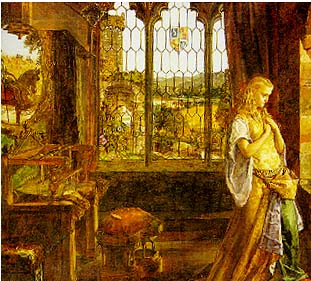
William Mau Egley, The Lady of Shalott 1858
a High Ggothic version full of antiquarian detail, a
relatively early example of the influence of Pre-Raphaelite medievalism
on other artists. ...with the authentic 14th-century costume, which 'clothes
somewhat incongruously the patently Victorian figure of Mrs. Egley, who
was the model" (Marsh 150-51). |
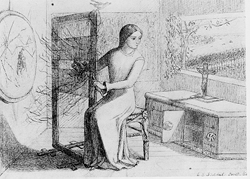
Elizabeth Siddal, The Lady of Shalott, 1853
|
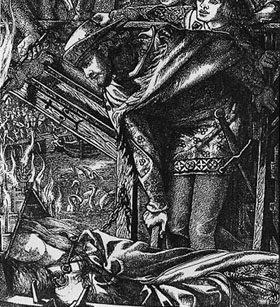
Dante Gabriel Rossetti, The Lady of Shallott,
1857
Wood engraving, 35/16 x 31/16 in.
Victoria and Albert Museum, London |
|
The Production of Culture
Culture industry, Standardization,
Pseudo Individuality
from Production of Culture/Culture
of Production
overriding theme:
the concentration of culture production within an industry that is
dominated by a few corporate producers [Disney+ABC+MacDonald's] who manufacture,
own the rights to and distribute a vast number of the mass-mediated cultural
products that are found in the world. The consequences of such concentration
are viewed as leading to a process of standardization of form and homogeneity
of content. The impact is perceived as, at best giving the consumer little
real choice, at worst promoting cultural forms that are dulling our ability
to think critically about the world in which we live and reducing the diversity
of values, beliefs and customs across the world.
Examples of standardization and pseudo-individuality
criticism of Adorno's theory
…TThis chapter will trace a broad theorectical shift from approaching
the production of culture through a macro perspective which stresses social
and organizational structures and economic relationships, towards a more
micro approach which focuses on everyday human agency and the making of
cultural meanings. The first approach foregrounds the issue of control
over production and constraint on creative practices; the second emphasizes
human autonomy and the active ability to engage in creative activities
despite such constraints.
Culture industry
'production line' and 'sausage machine'--music industry, book publishing
business and Hollywood film production
Adorno and Horkeimer
--how culture is industrialized
--the impact of [industrialization]on how cultural items were created
and consumed.
Mass culture'in which cultural production had become a routine, standardized
repetitive operation that produced undemanding cultural commodities which
in turn resulted in a type of consumption that was also standardized, distracted
and passive.
background
[against instrumental rationality prevalent in the first half of 20th
century.]
[personal history: witnessed 1914-1918 war, fled from Nazism in 1938
to the U.S. to find both the Nazi party and the U.S. make massive use of
media technologies.
Summary of the Three major arguments: production-creation-consumption
From a political-economy analysis which draws on Marx, they argue that
the concentration of culture production in a capitalist industry results
in a standardized commercial commodity.
Free and autonomous art against the repetitive and unchallenging culture
produced as a commodity
cultural consumption has become a de-concentrated activity leading
to passive and 'obedient' types of social behaviour.
Further explanation of standardization and pseudo-individuality
standardization: there is nothing
spontaneous about the process of cultural production: it has become a routine
operation that can be carried out in an office by the application of specific
formulae. E.g. production procedure, plan, repetitive sequences and frequently
recurring refrains.
Examples: Artist and mass production:
Springsteen and music video such as "Dancing in the Dark" "Born in the
U.S.A."; the textbook's example: jazz improvization, psalm, traditional
song, 'easy listening' -regressive listening
consequences: passive, obedient and easily manipulated consumption--e.g.
listen to the refrains and hooks of a hit song;
pseudo individuality--trade marks of car, music
and stars' images
"The constant pressure to produce new effects (which must conform to
the old pattern) serves merely as another rule to increase the power of
the conventions…}Pseudo individuality is rife: from the standardized jazz
improvization to the exceptional film star whose hair curls over her eye
to demonstrate her originality. "
Examples: Spice Girl, ±i´f©f¡A¤ýµá¡ADiana
hair style; car'different brands' and diffent years' models
criticism:
-
popular culture--not always standardized, controlled;
-
Do we need meaning and self-awareness in every activity, including entertainment?
-
distinction between the standardization of 'functional artifacts' such
as a car and 'music texts' such as songs.
-
Gendron (textbook p. 82) his point is that the standardization of components
in the car is qualitatively different to that in a song. How do we
interprete the 'part interchangeability' of music elements?
-
There is a limit in this productionist perspective. -- Different ways of
consumption


